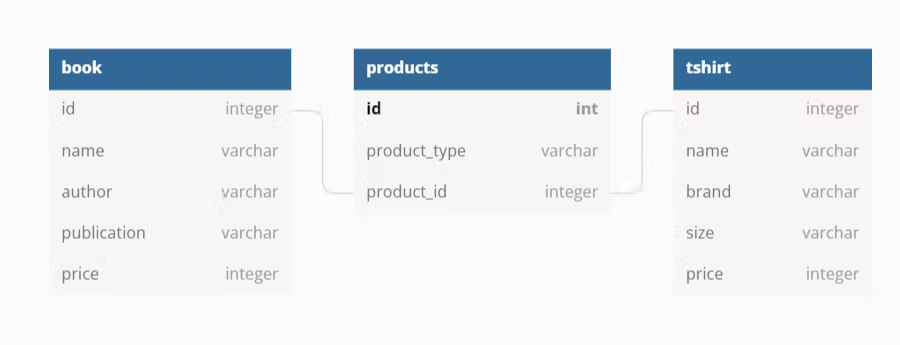Creating Polymorphic Relationships using Node.js and Sequelize
 Aayush Kurup
Aayush Kurup
In my last article, I explained what are polymorphic relationships. This blogs is a continuation of the same where I will demonstrate how to create a polymorphic relationship in node.js using the popular ORM sequelize.
Sequelize is one of the most popular Object Relational Mapper or ORM for SQL databases, written in node.js. It has more than 26k+ stars on github, and is used by some of the best companies in the world including Walmart Labs, Uphold and Snaplytics.
For this blog, we will first create a database models using Sequelize, then we will create an association between these models, and then finally, we will load the data using these associations. So without any further delay..... Let's get started.
Project Setup
First, we need to initialize our project. For that, we simply run the init command in our project directory as follows:-
npm init
or if you prefer yarn:-
yarn init
Now, we need to install the dependencies. For this project, we will be using Sequelize. Also we will be using a postgres database, so we need to install the it's driver. If you are using some other database like MySQL or MariaDB, make sure you install the correct driver for it. We will also use the dotenv package to store and retrieve environment variables. The command to install the dependencies:-
npm install --save sequelize pg dotenv
Connecting to the database
First and foremost, we will create a .env file to store all the database credentials.
/.env
DB_NAME=<Your DB name>
DB_USER=<Your DB user>
DB_PASSWORD=<Your DB Password>
DB_HOST=<Your DB hostname>
DB_PORT=<Your DB port>
Create the file and replace the values with your database credentials. Now, to load these values into your environment variables, we will use the dotenv package as follows.
./index.js
require('dotenv').config()
Finally, lets connect to our postgres database using sequelize:-
./db.js
const { Sequelize } = require('sequelize');
const conn = new Sequelize();
module.exports = conn
Creating Sequelize models
Lets create Sequelize models for our tables. We will create 3 models - Image, Video and Comment. Both images and videos can have comments. So comments will be a polymorphic table. Lets define our three models:-
/models/Image.js
const Sequelize = require('sequelize');
const conn = require('../db');
const Image = conn.define('images', {
id: {
type: Sequelize.INTEGER,
autoIncrement: true,
allowNull: false,
primaryKey: true
},
name: {
type: Sequelize.STRING,
allowNull: true,
},
url: {
type: Sequelize.STRING,
allowNull: false,
}
});
module.exports = Image;
/models/Videos.js
const Sequelize = require('sequelize');
const conn = require('../db');
const Video = conn.define('videos', {
id: {
type: Sequelize.INTEGER,
autoIncrement: true,
allowNull: false,
primaryKey: true
},
name: {
type: Sequelize.STRING,
allowNull: true,
},
url: {
type: Sequelize.STRING,
allowNull: false,
}
});
module.exports = Video;
/models/Comment.js
const Sequelize = require('sequelize');
const conn = require('../db');
const uppercaseFirst = str => `${str[0].toUpperCase()}${str.substr(1)}`;
class Comment extends Sequelize.Model {
getCommentable(options) {
if (!this.commentableType) return Promise.resolve(null);
const mixinMethodName = `get${uppercaseFirst(this.commentableType)}`;
return this[mixinMethodName](options);
}
}
Comment.init({
id: {
type: Sequelize.INTEGER,
autoIncrement: true,
allowNull: false,
primaryKey: true
},
commentableType: {
type: Sequelize.STRING,
allowNull: false,
},
commentableId: {
type: Sequelize.INTEGER,
allowNull: false,
},
headline: {
type: Sequelize.STRING,
allowNull: false,
},
body: {
type: Sequelize.STRING,
allowNull: true,
},
likes: {
type: Sequelize.INTEGER,
allowNull: true,
},
}, { sequelize: conn, modelName: 'comments' });
Comment.addHook("afterFind", findResult => {
if (!Array.isArray(findResult)) findResult = [findResult];
for (const instance of findResult) {
if (instance.commentableType === "image" && instance.image !== undefined) {
instance.commentable = instance.image;
} else if (instance.commentableType === "video" && instance.video !== undefined) {
instance.commentable = instance.video;
}
delete instance.image;
delete instance.dataValues.image;
delete instance.video;
delete instance.dataValues.video;
}
});
module.exports = Comment;
Nothing fancy here, I have simply defined three tables here.
But before we create the associations, let's have a closer look at our polymorphic table, i.e. the Comments model. I have defined a getCommentable method in the Comment class. The purpose of this method is to fetch the correct mixin for the commentable type under the hood. Mixins are basically methods that models acquire when they are in an association. I have also added a hook in the Comment model, which automatically adds comment field in every instance.
Creating the associations
Well all the heavy lifting was already done while defining the models. The hook and the getCommentable method in Comment will handle most of the heavy lifting. All we need to do now is create a one to many association between Video and Comment and also between Image and Comment. Add the following lines:-
/index.js
Image.hasMany(Comment, {
foreignKey: 'commentableId',
scope: {
commentableType: 'images'
}
});
Comment.belongsTo(Image, { foreignKey: 'commentableId' });
Video.hasMany(Comment, {
foreignKey: 'commentableId',
scope: {
commentableType: 'videos'
}
});
Comment.belongsTo(Video, { foreignKey: 'commentableId' });
That's it. Now we can query data from these models as follows:-
const videos = await Video.findAll({ include: Comment });
The result of this query will be:-
{
"id": 1,
"name": "Video 1",
"url": "Video Url 1",
"createdAt": "2022-08-06T05:16:01.700Z",
"updatedAt": "2022-08-06T05:16:01.700Z",
"comments": [
{
"id": 2,
"commentableType": "videos",
"commentableId": 1,
"headline": "Really cool video",
"body": null,
"likes": 0,
"createdAt": "2022-08-06T05:16:01.711Z",
"updatedAt": "2022-08-06T05:16:01.711Z"
},
{
"id": 1,
"commentableType": "videos",
"commentableId": 1,
"headline": "Nice video",
"body": null,
"likes": 0,
"createdAt": "2022-08-06T05:16:01.711Z",
"updatedAt": "2022-08-06T05:16:01.711Z"
}
]
}
Fin
Thanks for reading the blog. You can get all the code I used in this blog right here. If you want to learn more about sequelize, you can check out their website.
Subscribe to my newsletter
Read articles from Aayush Kurup directly inside your inbox. Subscribe to the newsletter, and don't miss out.
Written by

Aayush Kurup
Aayush Kurup
I am a Software Engineer from Bhopal, Madhya Pradesh, India. Currently, I am employed by Squareboat Solutions as a Software Engineer. I love working on a variety of technologies including Web Development, Mobile App Development and Deep Learning. My goal is to build highly performant applications that solve real-world problems and provide users with an awesome experience.